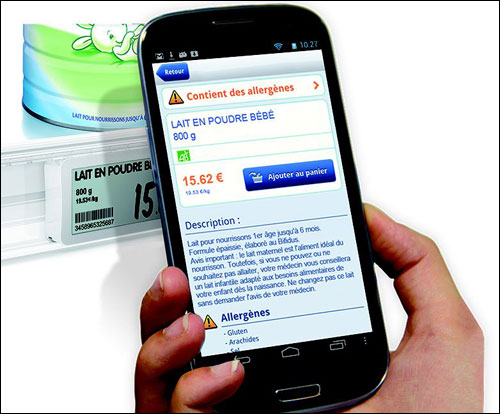Store Electronic Systems (SES), a French electronic shelf-labeling company, has developed—together with RFID integrated circuit (IC) provider NXP Semiconductors—a solution enabling retailers to share product information, coupons and loyalty bonuses with consumers via Near Field Communication (NFC) technology built into SES’ electronic shelf labels and the customers’ own smartphones.
SES’ electronic shelf-labeling technology, known as Radio Force X4 (RFX4), consists of radio transmitters and antennas that send out pricing and product data to battery-powered shelf labels via 36 kHz low-frequency (LF) signals, using a proprietary air-interface protocol. To date, the company reports, its electronic shelf-labeling systems have been installed at 5,300 stores within 50 countries. The firm’s electronic shelf labels, available in a variety of sizes and form factors, all have some sort of built-in screen for displaying the prices of the products stacked on a store’s shelving. Some SES labels can also present product-related text and graphics. The RFX4 system allows stores to update pricing and other product information by transmitting changes to each label.

The NFC-enabled electronic label comes with a high-definition, 127-dpi graphic screen, as well as an Identive 13.56 MHz passive NFC RFID tag made with NXP’s NTAG chip, compliant with the NFC Forum‘s Type 2 tag standard. With the addition of the NFC technology to the SES labels, retailers can share more data with consumers than is available on the label’s screen, by enabling users to access additional information via their NFC-enabled smartphones. The NFC-enabled labels have been in use at seven E.Leclerc hypermarkets, beginning with 47,000 labels installed during October 2012, and are being adopted this year by seven additional retail chains throughout France.
Upon arriving at one of the seven participating E.Leclerc stores, a customer can first download the retailer’s app onto his or her phone at an NFC RFID tag posted near an entrance or other commonly passed area. Then, while walking through the aisles, the shopper will see some basic product information, including each item’s name and pricing, displayed on the SES shelf labels. However, the patron can also tap the label with his or her phone, which then captures the unique ID number encoded to the label’s RFID tag, thereby directing the phone, via a 3G or Wi-Fi connection, to a link where it can access more data regarding that product, as well as coupons or loyalty benefits. The customer then redeems those coupons or points by presenting the phone to be read or viewed by the store’s checkout staff.
The inclusion of NFC technology in the shelf labels, says Guillaume Portier, SES’ marketing VP, provides “brick-and-mortar stores the ability to connect personally and seamlessly with end users within the stores.”
The 36 kHz signals used to transmit product updates to the labels can be sent from one label to another, Portier notes. These LF signals travel in transverse magnetic (TM) mode, he explains, and thus have the ability to penetrate or circumvent bottles of liquid, metal containers and other obstacles found within retail stores. What’s more, he adds, they do not interfere with other transmissions that the store may be employing.
The integration of NFC in the labels presented some challenges, says Giancarlo Cutrignelli, NXP’s global marketing manager. “It’s never easy to establish fixed guidelines as to how to integrate NFC,” he states. Electronic shelf labels come in varying sizes and often require a very small RFID tag, while users frequently have cost constraints as well. Because stores would typically use thousands of the labels, he says, the cost of adding NFC technology needed to be minimal.
A number of stores were already utilizing SES electronic shelf labels, Cutrignelli reports, so the firm was “not going to redesign the label from scratch to add NFC.” Instead, NXP worked with the company to ensure that the NFC tag could be installed within a very small space inside the label, and operate properly when surrounded “by wires and electronics.” He adds, “It’s not like taking a sticker and applying it to existing electronics.”
With the release of the new NFC-enabled shelf labels, Cutrignelli says, SES and NXP will demonstrate to the market the value of NFC technology in retail settings to “help consumers make an educated decision in the store.”
Without NFC, Cutrignelli says, store owners lack an understanding of the decision processes that consumers go through in stores while perusing products, until a consumer arrives at the point of sale. An owner may notice that a specific user always purchases a particular brand, but with the use of NFC, the store may also collect data indicating other goods in which a shopper is interested, based on the shelf labels that individual tapped with his or her phone. The store or product brand could then send that customer coupons relevant to the product he or she had not purchased, but had shown an interest in. “This is a great opportunity for stores,” Cutrignelli states.
The seven new retailer customers that are installing the technology this year have asked not to be named. “Those who are deploying wish, at this stage, not to communicate,” Portier explains, “as they want to conserve this dramatic competitive advantage.”


